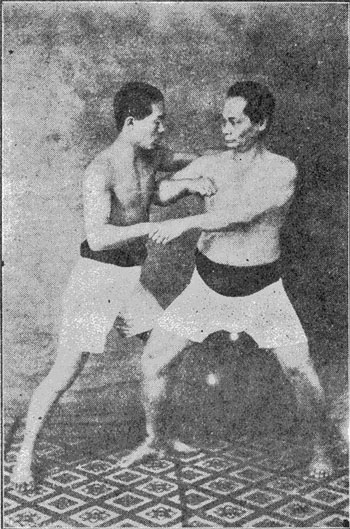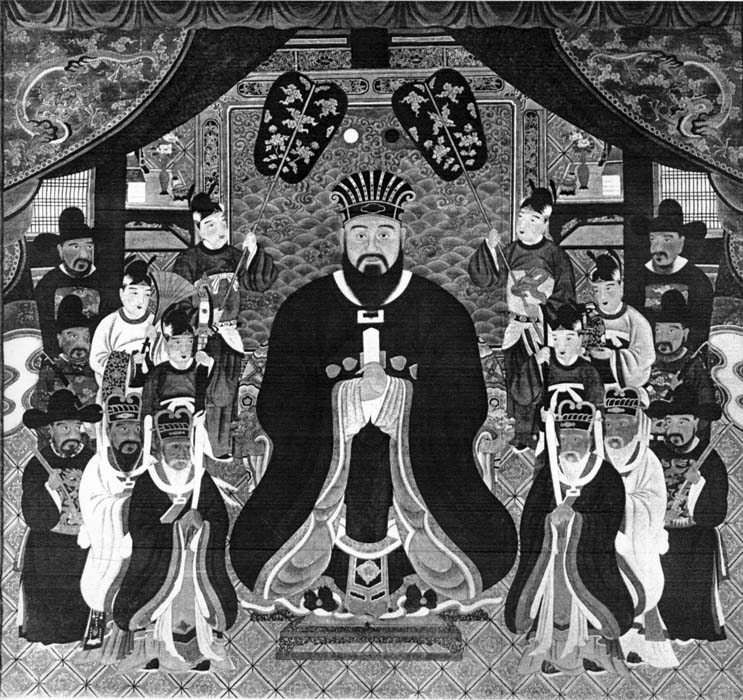|
Kumite
Kumite (, literally "grappling hands") is one of the three main sections of karate training, along with kata and kihon. Kumite is the part of karate in which a person trains against an adversary. Kumite can be used to develop a particular technique or a skill (e.g. effectively judging and adjusting one's distance from one's opponent) or it can be done in competition. Types Since the word "kumite" refers to forms of sparring, it covers a vast range of activities. In traditional Shotokan karate, the first type of kumite for beginners is ''gohon kumite''. The defender steps back each time, blocking the attacks and performing a counterattack after the last block. This activity looks nothing like the ''jiyu kumite'' (or "free sparring") practiced by more advanced practitioners. Types: * ''Ippon kumite'' - one step sparring, typically used for self-defense drills * ''Sanbon kumite'' - three-step sparring, typically used to develop speed, strength, and technique * ''Gohon kumite'' ... [...More Info...] [...Related Items...] OR: [Wikipedia] [Google] [Baidu] |
100-man Kumite
__NOTOC__ The 100-man kumite (Japanese: ''hyakunin kumite'') is an extreme test of physical and mental endurance in Kyokushin karate. Kumite is a form of sparring, one of the three main sections of karate training, and involves simulated combat against an opponent. The 100-man kumite consists of 100 rounds of kumite, each between one-and-a-half and two minutes in length. Normally, the karate practitioner undergoing the test will have to face similarly or higher-ranked opponents, and may face the same opponent more than once in the course of the test (depending on the number of opponents available to participate). Each opponent faced will be fresh and not fatigued or injured. Each of the rounds are done under test conditions, where either of the fighters are allowed to deliver knock out blows. The challenge was devised by Masutatsu Oyama, the founder of Kyokushin and the first person to complete the test. He completed the 100-man kumite three times over three consecutive days. The ... [...More Info...] [...Related Items...] OR: [Wikipedia] [Google] [Baidu] |
Kumite Of Motobu Choki
Kumite (, literally "grappling hands") is one of the three main sections of karate training, along with Kata (martial arts), kata and kihon. Kumite is the part of karate in which a person trains against an adversary. Kumite can be used to develop a particular technique or a skill (e.g. effectively judging and adjusting one's distance from one's opponent) or it can be done in competition. Types Since the word "kumite" refers to forms of sparring, it covers a vast range of activities. In traditional Shotokan, Shotokan karate, the first type of kumite for beginners is ''gohon kumite''. The defender steps back each time, blocking techniques, blocking the attacks and performing a counterattack after the last block. This activity looks nothing like the ''jiyu kumite'' (or "free sparring") practiced by more advanced practitioners. Types: * ''Ippon kumite'' - one step sparring, typically used for self-defense drills * ''Sanbon kumite'' - three-step sparring, typically used to develop ... [...More Info...] [...Related Items...] OR: [Wikipedia] [Google] [Baidu] |
Karatedo
(; ; Okinawan pronunciation: ), also , is a martial art developed in the Ryukyu Kingdom. It developed from the indigenous Ryukyuan martial arts (called , "hand"; ''tī'' in Okinawan) under the influence of Chinese martial arts. While modern karate is primarily a striking art that uses punches and kicks, traditional karate training also employs throwing and joint locking techniques. A karate practitioner is called a . Beginning in the 1300s, early Chinese martial artists brought their techniques to Okinawa. Despite the Ryukyu Kingdom being turned into a puppet state by Japanese samurai in 1609, after the Invasion of Ryukyu, its cultural ties to China remained strong. Since Ryukyuans were banned from carrying swords under samurai rule, groups of young aristocrats created unarmed combat methods as a form of resistance, combining Chinese and local styles of martial arts. Training emphasized self-discipline. This blend of martial arts became known as kara-te , which translates ... [...More Info...] [...Related Items...] OR: [Wikipedia] [Google] [Baidu] |
Karate
(; ; Okinawan language, Okinawan pronunciation: ), also , is a martial arts, martial art developed in the Ryukyu Kingdom. It developed from the Okinawan martial arts, indigenous Ryukyuan martial arts (called , "hand"; ''tī'' in Okinawan) under the influence of Chinese martial arts. While modern karate is primarily a striking art that uses punches and kicks, traditional karate training also employs Throw (grappling), throwing and joint locking techniques. A karate practitioner is called a . Beginning in the 1300s, early Chinese martial arts, Chinese martial artists brought their techniques to Okinawa. Despite the Ryukyu Kingdom being turned into a puppet state by Japanese samurai in 1609, after the Invasion of Ryukyu, its cultural ties to China remained strong. Since Ryukyuans were banned from carrying swords under samurai rule, groups of young aristocrats created unarmed combat methods as a form of resistance, combining Chinese and local styles of martial arts. Training emph ... [...More Info...] [...Related Items...] OR: [Wikipedia] [Google] [Baidu] |
Shotokan
is a style of karate, developed from various martial arts by Gichin Funakoshi (1868–1957) and his son Gigo (Yoshitaka) Funakoshi (1906–1945). Gichin Funakoshi was born in Okinawa and is widely credited with popularizing "karate do" through a series of public demonstrations, and by promoting the development of university karate clubs, including those at Keio, Waseda, Hitotsubashi (Shodai), Takushoku, Chuo, Gakushuin, and Hosei. Funakoshi had many students at the university clubs and outside dojos, who continued to teach karate after his death in 1957. However, internal disagreements (in particular the notion that competition is contrary to the essence of karate) led to the creation of different organisations—including an initial split between the Japan Karate Association (headed by Masatoshi Nakayama) and the Shotokai (headed by Motonobu Hironishi and Shigeru Egami), followed by many others—so that today there is no single "Shotokan school", although they a ... [...More Info...] [...Related Items...] OR: [Wikipedia] [Google] [Baidu] |
Bloodsport (film)
''Bloodsport'' is a 1988 martial arts film directed by Newt Arnold. An American-Hong Kong co-production, the film stars Jean-Claude Van Damme, with a supporting cast of Leah Ayres, Forest Whitaker, Donald Gibb, Roy Chiao, and Bolo Yeung. The film centers on Frank Dux (Van Damme), a United States Army Captain and ninjutsu practitioner who competes in an underground full-contact martial arts tournament called the Kumite in Hong Kong. Based on Dux's real-life claims, the film was marketed as a true story. It was one of Van Damme's first lead roles and showcased his abilities, launching his career as a mainstream action star. The screenplay is based on many of Dux's claims first covered in the November 1980 issue of ''Black Belt'' magazine. The real Dux served as the action choreographer and technical advisor. After its release, many of Dux's claims were disputed, including by co-screenwriter Sheldon Lettich, who claimed Dux fabricated his fight record and the existence of th ... [...More Info...] [...Related Items...] OR: [Wikipedia] [Google] [Baidu] |
World Karate Federation
The World Karate Federation (WKF) is an international governing body of sport karate with 198 member countries. It is the only karate organization recognised by the International Olympic Committee and has more than a hundred million members. The WKF organizes their Junior and Senior Karate World Championships, which are each held every other year. The President of the WKF is Antonio Espinós, and the headquarters are located in Madrid, Spain. History Karate was introduced to Europe around the 1950s by Japanese masters, mainly from the Japan Karate Association (JKA). In 1961, Jacques Delcourt was appointed President of French Karate Federation, which was at that stage an associated member of the French Judo Federation. In 1963 he invited the six other known European federations (Italy, Great Britain, Belgium, Germany, Switzerland and Spain) to come to France for the first-ever international karate event, and Great Britain and Belgium accepted the invitation. In December of ... [...More Info...] [...Related Items...] OR: [Wikipedia] [Google] [Baidu] |
Karate World Championships
The Karate World Championships, also known as the World Karate Championships, are the highest level of competition for karate organized by the World Karate Federation (WKF). The competition is held in a different city every two years. Championships in the 2000s included Madrid in 2002, Monterrey in 2004, Tampere in 2006, Tokyo in 2008, and Belgrade in 2010. The competition was initially riddled with controversy regarding karate styles and the ruleset. In 1980, women were first allowed to compete in the championships. Competition and events Kumite * Individual kumite – men and women * Team kumite – men and women Kumite Rules The result of a bout is determined by a contestant obtaining a clear lead of eight points, having the highest number of points at time-up, obtaining a decision (''hantei'' ), or by an accumulation of prohibited behaviors imposed against a contestant. Scoring & Penalties *''Ippon'' (three points) **''Jodan'' (head, face, neck) kicks **Any scori ... [...More Info...] [...Related Items...] OR: [Wikipedia] [Google] [Baidu] |
Blocking Techniques
In martial arts, blocking is the act of stopping or deflecting an opponent's attack for the purpose of preventing injurious contact with the body. A block usually consists of placing a limb across the line of the attack. Examples in specific arts Styles and types of blocking, as well as terminology, vary widely among the various martial arts. In Japanese martial arts such as Karate, these techniques are referred to as ''uke waza''. Examples include ''age uke'' (rising block) and ''shuto uke'' (knife hand guarding block). In Korean martial arts such as taekwondo, these techniques are referred to as (막기), with some examples being (rising block) and (knifehand guarding block). Some martial arts, such as Capoeira, reject blocking techniques completely as they consider them too inefficient. In Capoeira, they use evasion instead of blocking. Types of blocks Inside blocks An inside block deflects a strike away from the defender and away from the attacker. For example, agai ... [...More Info...] [...Related Items...] OR: [Wikipedia] [Google] [Baidu] |
Karate At The Summer Olympics
{{Rcat shell, {{R from alternative name ...
#REDIRECT Olympic Games The modern Olympic Games (Olympics; ) are the world's preeminent international Olympic sports, sporting events. They feature summer and winter sports competitions in which thousands of athletes from around the world participate in a Multi-s ... [...More Info...] [...Related Items...] OR: [Wikipedia] [Google] [Baidu] |






